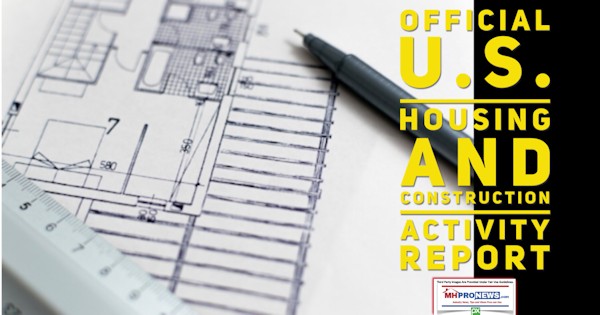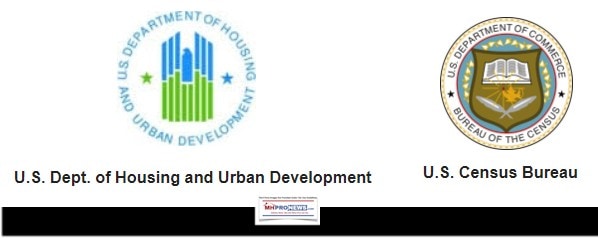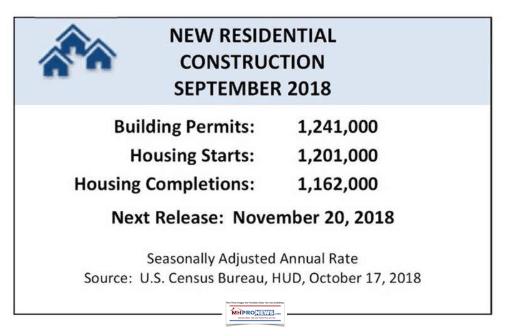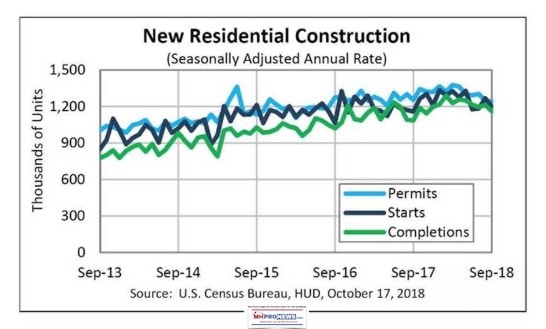
For the 6th month in a row, existing home sales have dropped, says the National Association of Realtors, as reported by CNBC.
- U.S. home sales fell in September by the most in over two years as the housing market continued to struggle despite strength across the broader economy.
- The National Association of Realtors ™ (NAR) said on Friday that existing home sales dropped 3.4 percent to a seasonally adjusted annual rate of 5.15 million units last month.
Among the factors cited were rising interest rates.
The median house price increased 4.2 percent from one year ago to $258,100 in September.
So why are manufactured homes still struggling to achieve 100,000 new home shipments a year? Even adding in the cost of a home site, in the data summarized in the linked report below, reveals what should be a roaring manufactured housing market.
For more on the question of why sales are so low, see the related reports, linked further below. But next up, are the official HUD and U.S. Census Bureau residential construction data.

HUD AND CENSUS BUREAU REPORT RESIDENTIAL CONSTRUCTION ACTIVITY IN SEPTEMBER 2018
WASHINGTON – The U.S. Department of Housing and Urban Development (HUD) and the U.S. Census Bureau jointly announced the following new residential construction statistics for September 2018.
Building Permits: Privately owned housing units authorized by building permits in September were at a seasonally adjusted annual rate of 1,241,000. This is 0.6 percent (±1.2 percent)* below the revised August rate of 1,249,000, and is 1.0 percent (±1.2 percent)* below the September 2017 rate of 1,254,000. Single-family authorizations in September were at a rate of 851,000; this is 2.9 percent (±1.2 percent) above the revised August figure of 827,000. Authorizations of units in buildings with five units or more were at a rate of 351,000 in September.

Housing Starts: Privately owned housing starts in September were at a seasonally adjusted annual rate of 1,201,000. This is 5.3 percent (±11.3 percent)* below the revised August estimate of 1,268,000, but is 3.7 percent (±12.1 percent)* above the September 2017 rate of 1,158,000. Single-family housing starts in September were at a rate of 871,000; this is 0.9 percent (±8.9 percent)* below the revised August figure of 879,000. The September rate for units in buildings with five units or more was 324,000.
Housing Completions: Privately owned housing completions in September were at a seasonally adjusted annual rate of 1,162,000. This is 4.1 percent (±11.3 percent)* below the revised August estimate of 1,212,000 but is 7.0 percent (±12.9 percent)* above the September 2017 rate of 1,086,000. Single-family housing completions in September were at a rate of 844,000; this is 8.7 percent (±8.4 percent) below the revised August rate of 924,000. The September rate for units in buildings with five units or more was 312,000.

The October report is scheduled for release on November 20, 2018.
EXPLANATORY NOTES
In interpreting changes in the statistics in this release, note that month-to-month changes in seasonally adjusted statistics often show movements which may be irregular. It may take three months to establish an underlying trend for building permit authorizations, six months for total starts, and six months for total completions. The statistics in this release are estimated from sample surveys and are subject to sampling variability as well as nonsampling error including bias and variance from response, nonreporting, and undercoverage. Estimated relative standard errors of the most recent data are shown in the tables. Whenever a statement such as “2.5 percent (±3.2 percent) above” appears in the text, this indicates the range (-0.7 to +5.7 percent) in which the actual percentage change is likely to have occurred. All ranges given for percentage changes are 90 percent confidence intervals and account only for sampling variability. If a range does not contain zero, the change is statistically significant. If it does contain zero, the change is not statistically significant; that is, it is uncertain whether there was an increase or decrease. The same policies apply to the confidence intervals for percentage changes shown in the tables. On average, the preliminary seasonally adjusted estimates of total building permits, housing starts and housing completions are revised 3 percent or less.
* The 90 percent confidence interval includes zero. In such cases, there is insufficient statistical evidence to conclude that the actual change is different from zero.
###
There are a range of factors that ought to be pointing to far higher sales by manufactured housing firms. See the related reports, further below. That’s “News through the lens of manufactured homes, and factory-built housing,” © where “We Provide, You Decide.” © ## (News, analysis, and commentary.)
(Related Reports are further below. Third-party images and content are provided under fair use guidelines.)
1) To sign up in seconds for our MH Industry leading emailed news updates, click here.

2) To pro-vide a News Tips and/or Commentary, click the link to the left. Please note if comments are on-or-off the record, thank you.
3) Marketing, Web, Video, Consulting, Recruiting and Training Re-sources

Related Reports:
Manufactured Housing Institute Shipment Data, FEMA, an Inside Look
New National Manufactured Housing Association Makes Its Appeal to Industry Members
